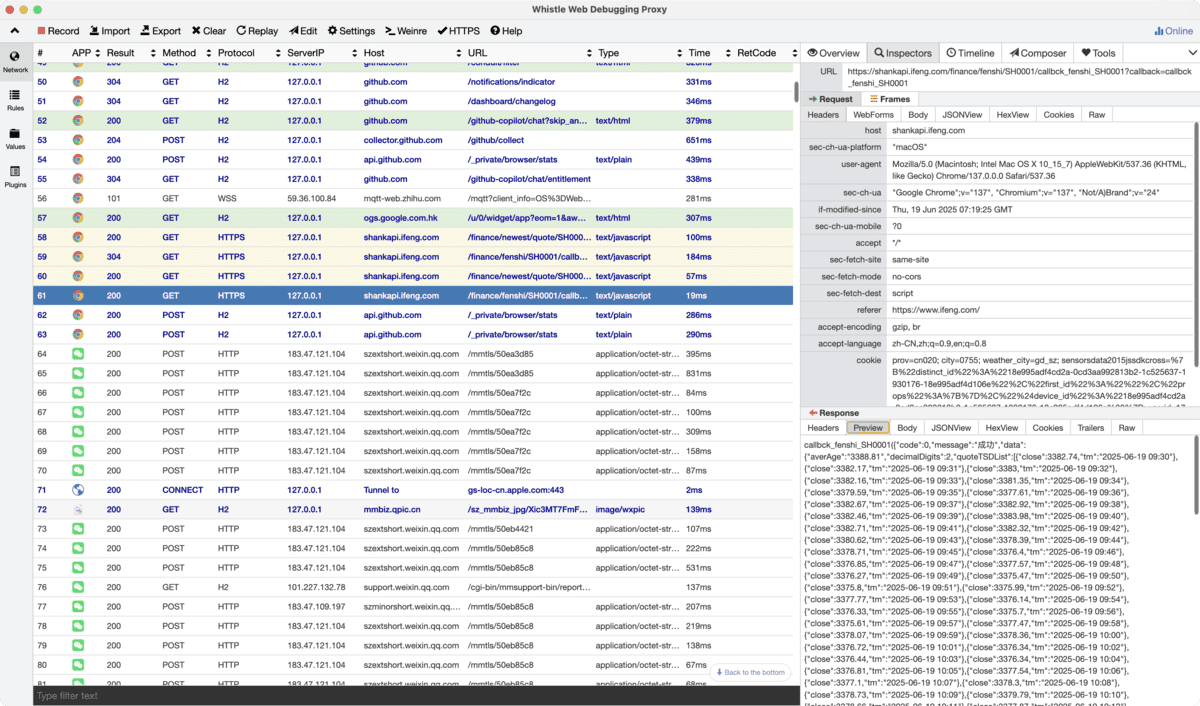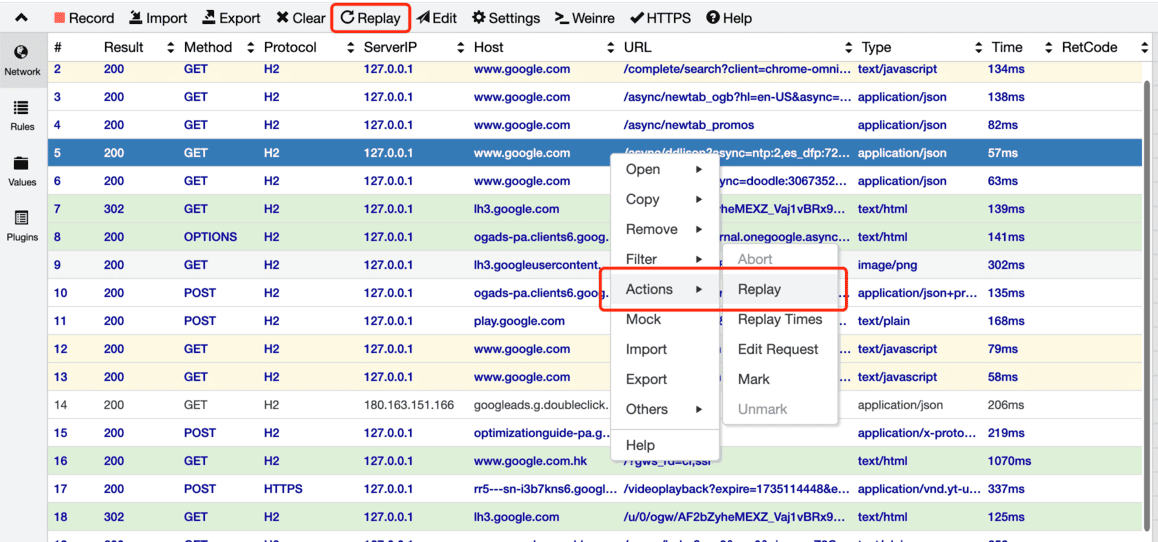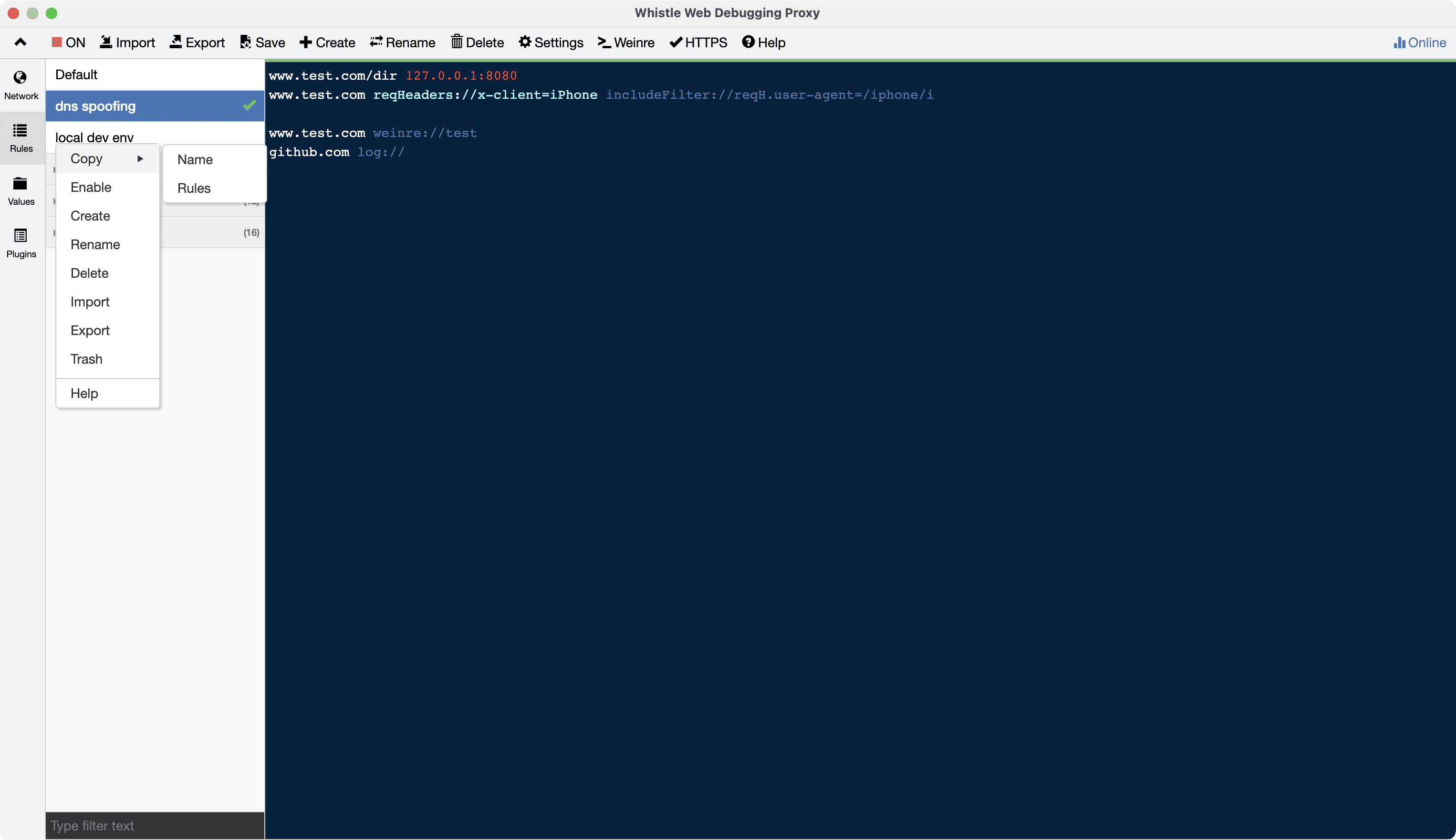Getting Started
After installation is complete
- Client Version: Launch the desktop application directly
- Command Line Version: Visit http://local.whistlejs.com in your browser
You will now be able to access the user interface:

Key User Interface Features:
- Network: Real-time packet capture analysis and request replay/editing
- Rules: Rule configuration interface for modifying requests and responses
- Values: Action content configuration interface (supports calling rule variables)
- Plugins: Plugin management interface
User Interface Examples
- Replaying a Request
Click a request and click the
Replaybutton at the top, or right-click the request list and select Actions -> Replay
 2. Editing or Constructing a Request > Click a request and click the `Edit` button at the top button, or right-click the request list and select Actions -> Edit Request.
2. Editing or Constructing a Request > Click a request and click the `Edit` button at the top button, or right-click the request list and select Actions -> Edit Request. 
For full functionality, see: Interface Features
Rule Configuration Example

Whistle modifies requests and responses through simple rule configuration. The basic syntax is as follows:
pattern operation [includeFilter://pattern1 ... excludeFilter://patternN ...]Rules consist of three core components:
- Match Pattern (
pattern): An expression that matches the request URL. Multiple formats are supported:- Domain Match:
www.test.com(matches all requests to that domain, including the port) - Path Match:
www.test.com/path - Regular expression:
/^https?://test\.com//i - Wildcards:
*.test.com,**.test.com/pathWhistle supports three URL types:
- Tunnel proxy:
tunnel://domain[:port] - WebSocket:
ws[s]://domain[:port]/path/to - Normal HTTP/HTTPS:
http[s]://domain[:port]/path/to
- Tunnel proxy:
- Domain Match:
- Operation instruction (
operation), format:protocol://valueprotocol: Operation type, e.g.:reqHeaders: Modify request headersresHeaders: Modify response headersvalue: Operation content, supports multiple data sources:- Inline value:
reqHeaders://x-proxy-by=whistle(directly add request headers) - Local file:
file://path/to/file - Remote resource:
https://example.com/data.json - Default variable:
{key}(read from embedded values or Values in Rules)protocol://in operation can be omitted in the following two scenarios:iporip:port: Equivalent tohost://iporhost://ip:portD:\path\to,/path/to, or{key}: Equivalent tofile://D:\path\to,file:///path/to, orfile://{key}
- Filter Conditions (Optional) (
includeFilter/excludeFilter)- Logical relationship: Multiple conditions are matched in an "or" fashion; a filter is considered valid if any one of the conditions matches.
- Match scope:
- Request: URL, method (GET/POST, etc.), header fields, content, client IP
- Response: Status code, header fields, content, server IP
Example 1: Modify DNS (Set Hosts)
- Domain Matchingtxt
www.test.com 127.0.0.1 # Supports with port www.test.com 127.0.0.1:8080 # CNAME function (port optional) www.test.com host://www.example.com:8181 - Path Matchingtxt
www.test.com/path/to 127.0.0.1:8080 # Supports with protocol https://www.test.com/path/to 127.0.0.1:8080 # Applies only to tunnel proxy requests tunnel://* 127.0.0.1:8080 - Wildcard Matchingtxt
# Domain wildcard, matching all subdomains of test.com **.test.com 127.0.0.1:8080 # Supports domain wildcards with protocols https://**.test.com 127.0.0.1:8080 # Path wildcard (* is a valid path character, so add a leading ^ to indicate to Whistle that it is a wildcard) ^**.test.com/*/path/to 127.0.0.1:8080 # Supports path wildcards with protocols ^https://**.test.com/*/path/to 127.0.0.1:8080*,**, and***have different matching scopes. See the documentation: pattern - Regular Expression Matchingtxt
# `/` in a rule regular expression Escape or not /^https?://\w+\.test\.com/ 127.0.0.1:8080/regexp/xis equivalent tonew RegExp(regexp, x) - Filter Matchingtxt
# Request URL matches `pattern` and the request header `cookie` contains `env=test` pattern 127.0.0.1:8080 includeFilter://reqH.cookie=/env=test/ # Only applies to requests initiated from iPhones https://www.test.com/path/to 127.0.0.1:8080 includeFilter://reqH.user-agent=/iPhone/i
Example 2: Modifying Form Data
# Modify the value of the `test` field in the form
pattern reqMerge://test=123
# Delete the `abc` field in the form.
pattern delete://reqBody.abcExample 3: Setting a Cross-Origin Response Header
# Set a cross-origin response header with Access-Control-Allow-Origin: * and exclude OPTION requests.
pattern resCors://* excludeFilter://m:option
# Cross-origin request headers other than `*`
pattern resCors://enableAdvanced Rule Configuration
- Combined Configurationtxt
pattern operation1 operation2 ... [includeFilter://pattern1 ... excludeFilter://patternN ...] - Reversing Positions (
pattern1andoperationmust not both be URLs or domain names)This means they must not both be URLs or domain names like
https://test.com/path,//test.com/path,test.com/path, ortest.com.txtoperation pattern1 pattern2 ... [includeFilter://pattern1 ... excludeFilter://patternN ...] - Line Break Configurationtxt
line` operation pattern1 pattern2 ... [includeFilter://pattern1 ... excludeFilter://patternN ...] `Whistle will automatically replace line breaks within code blocks with spaces.
For complete functionality, see: Rule Configuration